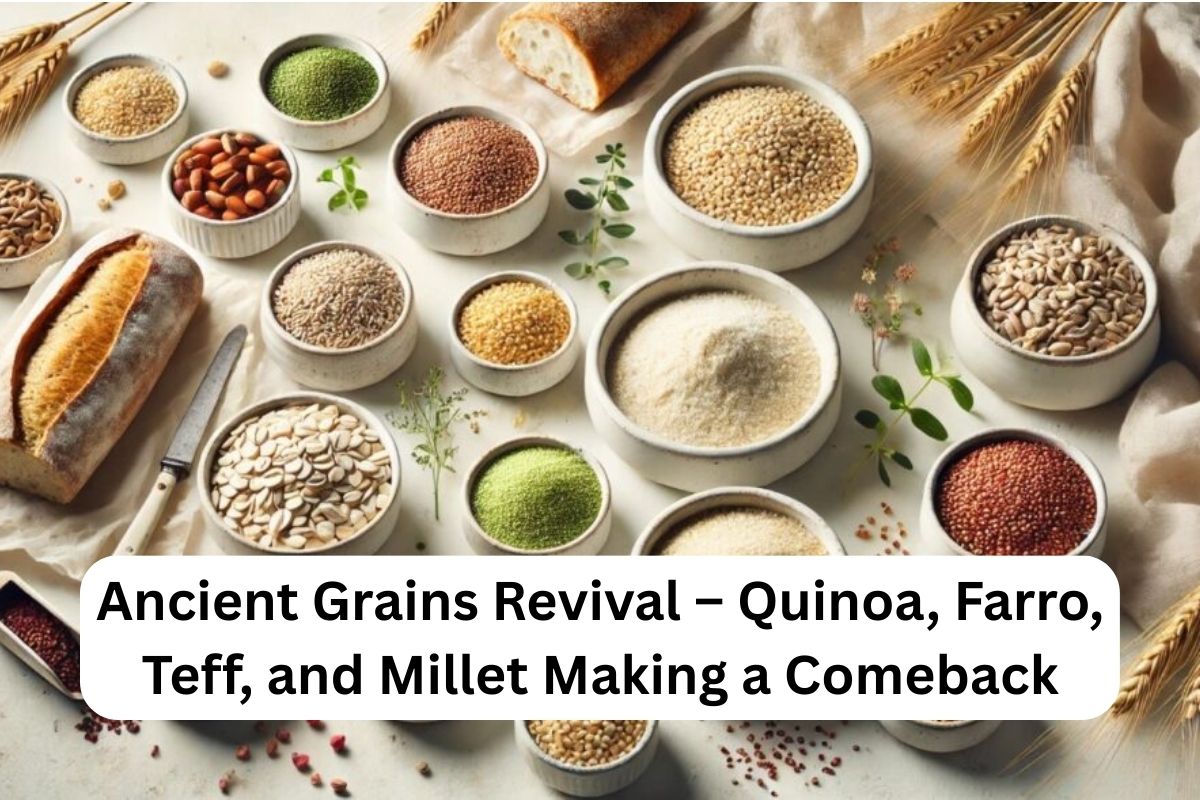For centuries, civilizations thrived on ancient grains like quinoa, farro, teff, and millet. These grains provided strength, energy, and nutrition long before refined wheat and processed rice took over global diets. Now, in 2025, they are experiencing a revival as people seek healthier, sustainable, and nutrient-rich alternatives to modern grains.
This comeback isn’t just about health—it’s also about rediscovering tradition, sustainability, and the powerful role whole foods play in modern lifestyles. Ancient grains are gluten-friendly, packed with fiber, and rich in minerals, making them a favorite in both wellness communities and gourmet kitchens.
Why Are Ancient Grains Making a Comeback?
The rising demand for nutrient-dense and sustainable foods has brought ancient grains back into the spotlight. Unlike refined grains, they are less processed, retain more nutrients, and often thrive in harsh climates, making them more eco-friendly.
Key reasons for their revival:
- Health-conscious choices: People are shifting toward natural, unprocessed foods.
- Gluten alternatives: Many ancient grains are naturally gluten-free.
- Sustainability: These crops require fewer resources and adapt to various climates.
- Culinary diversity: Chefs use them in salads, breads, porridges, and even desserts.
Spotlight on Popular Ancient Grains
1. Quinoa – The Incan Superfood
Once called the “Mother Grain” by the Incas, quinoa is technically a seed but consumed like a grain. It’s high in protein, rich in iron, and contains all nine essential amino acids. Its versatility allows it to be used in salads, soups, and even gluten-free baking.
2. Farro – The Grain of Roman Soldiers
Farro, an ancient wheat variety, fueled Roman legions with its hearty nutrition. Rich in fiber, magnesium, and zinc, farro provides slow-digesting carbs that help sustain energy levels. It’s especially popular in Mediterranean cuisines, used in risottos, soups, and grain bowls.
3. Teff – Ethiopia’s Tiny Powerhouse
Teff, a tiny grain from Ethiopia, is the main ingredient in injera bread. It’s loaded with calcium, iron, and resistant starch that supports gut health. Its mild, nutty flavor makes it ideal for porridges, pancakes, and baking mixes.
4. Millet – The Ancient Asian Staple
Millet has been a staple in Asia and Africa for thousands of years. Naturally gluten-free and rich in antioxidants, millet is praised for its ability to regulate blood sugar. It can be prepared like rice, puffed into cereals, or used in flatbreads.
Nutritional Comparison of Ancient Grains
| Grain | Protein (per cup, cooked) | Fiber (per cup, cooked) | Key Nutrients | Best Uses |
|---|---|---|---|---|
| Quinoa | 8g | 5g | Iron, Magnesium, Amino Acids | Salads, soups, gluten-free baking |
| Farro | 7g | 7g | Zinc, Magnesium, Antioxidants | Soups, risottos, grain bowls |
| Teff | 10g | 7g | Calcium, Iron, Resistant Starch | Porridge, bread, pancakes |
| Millet | 6g | 2g | Antioxidants, Phosphorus | Flatbreads, cereals, rice substitute |
Culinary and Lifestyle Trends with Ancient Grains
- Modern Baking: Gluten-free flours made from quinoa, teff, and millet are booming.
- Wellness Bowls: Ancient grain bowls with veggies and protein are a restaurant trend.
- Sports Nutrition: Athletes prefer them for long-lasting energy and recovery.
- Cultural Revival: Traditional foods like Ethiopian injera and Indian millet roti are gaining global attention.
Ancient Grains and Sustainability
Ancient grains aren’t just good for us—they’re good for the planet. They thrive in tough environments, need less water than rice or wheat, and are often grown without heavy chemical use. By reviving these grains, we also support biodiversity and promote food security in a changing climate.
Astrology & Ancient Grains – A Unique Connection
Astrology links wellness and food choices to planetary energies. Ancient grains, being deeply tied to Earth, represent grounding, balance, and nourishment.
- Quinoa: Associated with Virgo for its purity and digestive benefits.
- Farro: Linked to Capricorn, symbolizing strength and endurance.
- Teff: Connected to Scorpio, reflecting hidden power in its tiny size.
- Millet: Resonates with Taurus, symbolizing stability and nourishment.
This perspective adds a mystical layer to the revival, making ancient grains not just physical fuel but spiritual food as well.
The ancient grains revival is more than a food trend—it’s a return to our roots. Quinoa, farro, teff, and millet are making their way back into kitchens worldwide, offering unmatched nutrition, sustainability, and cultural depth. From athletes to health-conscious eaters to chefs, everyone is embracing these grains for a healthier and more balanced lifestyle.
By rediscovering these grains, we’re not just eating—we’re connecting to history, culture, and the Earth itself.
FAQs About Ancient Grains Revival
1. Are ancient grains healthier than modern wheat?
Yes, they are less processed, higher in nutrients, and often easier to digest than refined wheat.
2. Can people with gluten intolerance eat ancient grains?
Yes, grains like quinoa, teff, and millet are gluten-free, though farro contains gluten.
3. How do I cook ancient grains?
Most can be cooked like rice—boiled in water or broth until tender.
4. Are ancient grains good for weight loss?
Yes, their fiber and protein keep you full longer, helping manage appetite.
5. Where can I buy ancient grains?
They’re available in supermarkets, health stores, and online retailers worldwide.
